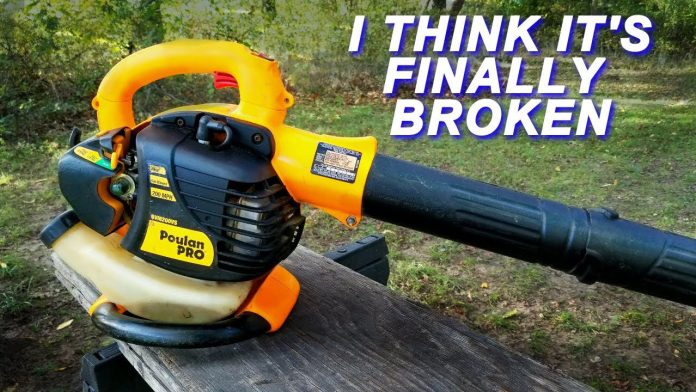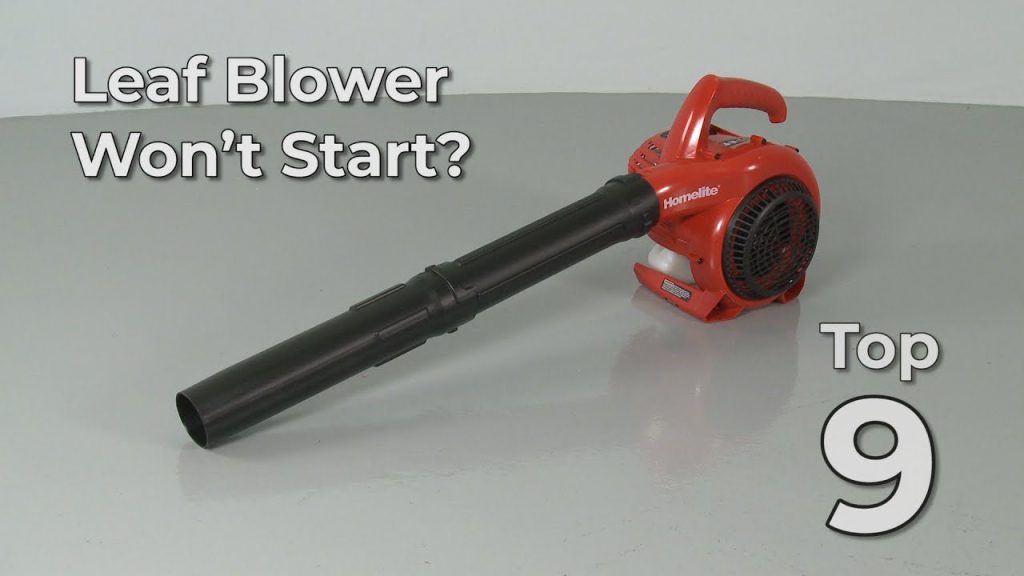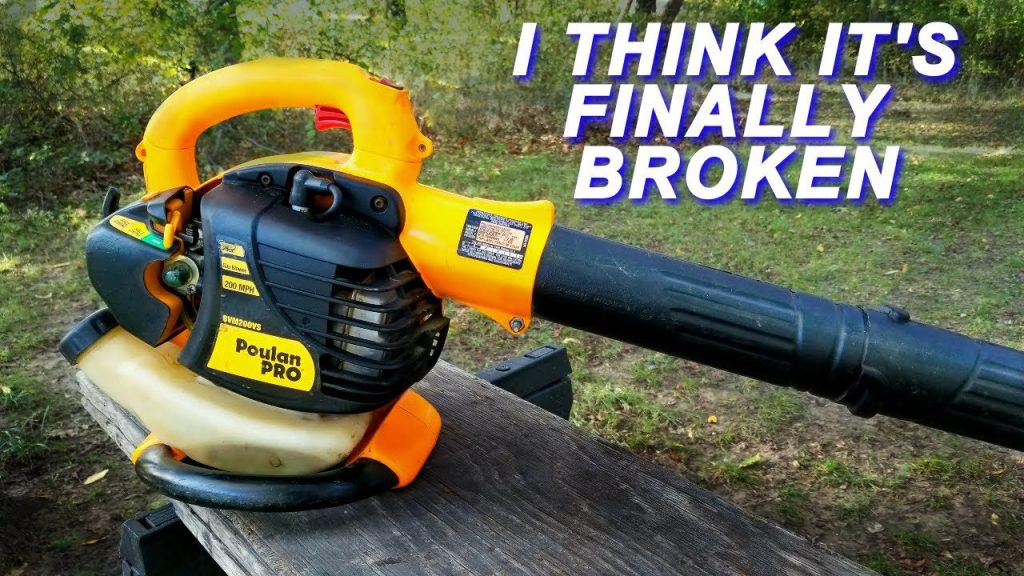Are you tired of constantly having to stop and restart your leaf blower every few minutes? Well, fret no more! In this article, we will share some valuable tips and tricks on how to fix a leaf blower that keeps stopping. From checking the fuel mixture to cleaning the air filter, we’ve got you covered. So, say goodbye to those frustrating interruptions and get ready to tackle your yardwork like a pro!
Possible Causes
Leaf blowers are incredibly useful tools when it comes to maintaining a clean and tidy yard. However, just like any other machine, they can encounter issues that may cause them to stop working. Here are some possible causes for a leaf blower that keeps stopping:
Fuel Problems
One of the common culprits behind a leaf blower that keeps stopping is fuel-related issues. To address this, there are a few components you can check:
Check Fuel Level
Start by ensuring that there is an adequate amount of fuel in the tank. Running out of fuel can cause the leaf blower to stop abruptly, so it’s important to monitor the fuel level regularly.
Inspect Fuel Filter
A clogged fuel filter can hinder the flow of fuel to the engine, leading to performance issues. Take a look at the fuel filter and clean or replace it if necessary.
Clean or Replace Fuel Lines
Over time, fuel lines can become clogged or damaged, affecting the flow of fuel. Inspect the fuel lines for any blockages or leaks, and clean them or replace them if needed.
Clean or Replace Gas Cap
A faulty gas cap can disrupt the proper combustion process, causing the leaf blower to stall. Clean the gas cap thoroughly, ensuring that it’s free from any debris. If cleaning doesn’t resolve the issue, consider replacing the gas cap.
Drain and Refill Fuel Tank
If none of the above solutions solve the problem, it may be necessary to drain and refill the fuel tank completely. This can help eliminate any potential contaminants or issues with the fuel itself.
Electrical Issues
Electrical problems can also be a reason why your leaf blower keeps stalling. To tackle this, examine the following components:
Check Power Source
Ensure that the power source you’re using, such as an extension cord or battery, is providing the correct voltage and is in good condition. Faulty power sources can lead to inconsistent performance or frequent stalling.
Inspect Wiring Connections
Inspect the wiring connections of your leaf blower for any loose or damaged wires. Secure any loose connections and repair or replace any damaged wires to guarantee a stable electrical connection.
Test Ignition Coil
The ignition coil is responsible for generating the spark that ignites the fuel in the engine. A faulty ignition coil can cause the leaf blower to stop working suddenly. Use a multimeter to test the ignition coil’s resistance and replace it if necessary.
Check Circuitry with Multimeter
Using a multimeter, check the circuitry of your leaf blower for any abnormalities or faulty components. Test the switches and buttons to ensure they’re functioning correctly. Replace any faulty switches or buttons to restore proper operation.
Air Filter Clog
A clogged air filter can restrict airflow to the engine, resulting in poor performance or stalling. To address this issue, follow these steps:
Locate and Remove Air Filter
Find the air filter housing on your leaf blower and remove it carefully. The air filter is typically located inside the housing and can be easily accessed.
Inspect Filter for Dirt or Blockages
Take a close look at the air filter and check for dirt, debris, or other blockages. A dirty or clogged filter will need to be cleaned or replaced.
Clean or Replace Air Filter
If the air filter is dirty, gently clean it with compressed air or wash it with warm soapy water. Allow it to dry completely before reinstalling. If the filter is damaged or extensively clogged, replace it with a new one.
Reinstall Air Filter Properly
When reinstalling the air filter, ensure it is positioned correctly and securely in the housing. A loose or improperly installed air filter can impact the blower’s performance.
Carburetor Problems
Issues with the carburetor can also contribute to a leaf blower’s frequent stalling. Here’s what you can do to address carburetor-related problems:
Clean Carburetor
Over time, the carburetor can become clogged with gunk and residue from the fuel. Remove the carburetor, disassemble it, and clean the various components with carburetor cleaner spray. Be sure to follow the manufacturer’s instructions and wear appropriate protective gear.
Inspect Carburetor for Damage
While cleaning the carburetor, inspect it for any signs of damage such as cracks or corrosion. If any components are damaged, they will need to be replaced.
Check Fuel Delivery
Ensure that fuel is reaching the carburetor properly. Check the fuel lines, fuel filter, and fuel pump to ensure they’re functioning correctly and delivering fuel at the proper rate.
Adjust Carburetor Settings
If the carburetor settings are misaligned, the leaf blower may stall frequently. Use the manufacturer’s instructions to adjust the carburetor settings, such as the idle speed and air-fuel mixture, if necessary.
Replace Faulty Carburetor Parts
If all else fails, and the carburetor continues to cause issues, it may be necessary to replace faulty carburetor parts. Consult the manufacturer’s instructions or seek professional assistance for guidance on identifying and replacing the appropriate components.
Spark Plug Issues
A malfunctioning spark plug can disrupt the combustion process, resulting in a leaf blower that frequently stalls. Consider the following steps to address spark plug-related problems:
Remove Spark Plug
Locate the spark plug wire and carefully remove it from the spark plug. Use a spark plug socket and ratchet to carefully remove the spark plug from the engine.
Inspect Spark Plug for Fouling
Examine the spark plug for any signs of fouling, such as excessive carbon deposits or oil buildup. Fouled spark plugs can hinder ignition and cause the engine to stall. Clean the spark plug or replace it if necessary.
Clean or Replace Spark Plug
If the spark plug is fouled, clean it using a wire brush and spark plug cleaner or replace it with a new one. Follow the manufacturer’s recommendations for the appropriate spark plug type.
Adjust Spark Plug Gap
Ensure that the spark plug gap is set correctly according to the manufacturer’s specifications. An incorrect gap can lead to poor ignition and intermittent stalling.
Check Spark Plug Ignition
Once the spark plug is cleaned or replaced, reconnect the spark plug wire and test for proper ignition. The spark plug should emit a spark when the engine is started.
By addressing these potential causes and following the recommended troubleshooting steps, you can ensure that your leaf blower operates smoothly and efficiently. Regular maintenance and periodic inspections will also help prevent future issues from occurring.
This image is property of i.ytimg.com.
Air Flow Problems
In addition to the causes mentioned above, air flow problems can also contribute to a leaf blower’s frequent stalling.
Inspect Air Intake
Check the air intake of your leaf blower for any obstructions. Leaves, debris, or other foreign objects may hinder the proper flow of air to the engine, causing the blower to stall. Clear away any blockages and ensure that the air intake is clean and unrestricted.
Remove Obstructions
Inspect the blower’s nozzle and tube for any obstructions, such as accumulated debris or objects. Clear away any obstructions to ensure that air can flow freely through the blower.
Check Exhaust System
A clogged or faulty exhaust system can disrupt the flow of exhaust gases and cause the blower to stall. Inspect the exhaust system for any blockages or damage. Clear any obstructions or replace damaged components as needed.
Clean or Replace Muffler
A clogged or damaged muffler can impede the flow of exhaust gases, affecting the blower’s performance. Remove the muffler and clean it thoroughly. If it’s heavily corroded or damaged, consider replacing it with a new one.
Inspect and Clean Cooling System
A leaf blower’s cooling system plays a crucial role in preventing overheating. Inspect the cooling fins and ensure they are clean and free from debris. Clean the cooling system thoroughly if necessary to optimize heat dissipation.
By addressing air flow problems and ensuring proper ventilation, you can enhance the performance and prevent stalling in your leaf blower.
This image is property of i.ytimg.com.
Overheating Issues
Leaf blowers can sometimes overheat, resulting in frequent stalling. Here’s how you can tackle overheating issues:
Allow the Blower to Cool Down
If your leaf blower starts to overheat, allow it to cool down before attempting to use it again. Give the engine sufficient time to reach a safe temperature to prevent further damage.
Check for Engine Overload
Overloading the engine by using the leaf blower beyond its capacity can lead to overheating and stalling. Ensure that you’re using the blower within its recommended limits and avoid pushing it to exert excessive force.
Inspect Cooling Fins
The cooling fins in a leaf blower help dissipate heat. Inspect the cooling fins for any damage or blockages. Clean them carefully using compressed air or a soft brush to remove any debris.
Clean or Replace Cooling Fins
If the cooling fins are clogged or damaged beyond repair, they may need to be replaced. Consult the manufacturer’s instructions or seek professional assistance to ensure the proper replacement process.
Improve Air Circulation
Enhancing air circulation around the leaf blower can aid in preventing overheating. Make sure that there is enough space around the blower for proper ventilation. Avoid operating the blower in enclosed or congested areas to prevent overheating.
This image is property of i.ytimg.com.
Lubrication Problems
Insufficient or improper lubrication can also lead to a leaf blower that frequently stalls. Take the following steps to address any lubrication-related issues:
Check Lubricant Levels
Ensure that the lubricant levels in your leaf blower are sufficient. Consult the manufacturer’s instructions to determine the appropriate amount and type of lubricant required for your specific model.
Inspect Lubrication System
Inspect the lubrication system of your leaf blower for any leaks, blockages, or other issues. Ensure that all lubricant passages are clear and functional. Repair or replace any faulty components that may be compromising the lubrication system.
Clean or Replace Lubricant
If the lubricant in your leaf blower is contaminated or degraded, it can impact the performance and cause stalling. Drain the old lubricant and refill with fresh, high-quality lubricant appropriate for your blower.
Ensure Proper Lubrication
Proper lubrication of moving parts is critical to reducing friction and preventing overheating. Follow the manufacturer’s recommendations for lubricating specific components, such as the engine bearings or piston rings. Regularly lubricate the specified areas to ensure optimal performance and minimize stalling.
This image is property of i.ytimg.com.
Preventive Maintenance
Regular preventive maintenance plays a crucial role in keeping your leaf blower running smoothly. Consider the following practices to avoid frequent stalling and prolong the lifespan of your blower:
Regularly Clean and Inspect Blower
Keep your leaf blower clean and free from dirt, debris, and other obstructions. Regularly inspect all components for damage or wear. Promptly clean or replace any worn-out parts to maintain optimal performance.
Follow Manufacturer’s Guidelines
Refer to the manufacturer’s guidelines and recommendations for maintenance intervals and procedures. Adhere to the specified maintenance schedule, including oil changes, filter replacements, and general servicing. Following these guidelines can prevent potential issues and ensure your blower operates efficiently.
Use Quality Fuel and Lubricant
Using high-quality fuel and lubricant in your leaf blower can significantly impact its performance and reliability. Opt for fuel and lubricants recommended by the manufacturer to ensure compatibility and optimal results.
Store Properly after Use
Properly storing your leaf blower when not in use can help prevent issues such as fuel degradation, moisture buildup, and damage. Store the blower in a clean, dry location, away from direct sunlight and extreme temperatures. Follow the manufacturer’s instructions for storing specific models.
Maintain a Clean Air Filter
Regularly clean or replace the air filter in your leaf blower to promote proper airflow and prevent stalling. A clogged or dirty air filter can significantly affect performance, so make it a habit to check and clean the filter regularly.
By following these preventive maintenance practices, you can keep your leaf blower in excellent working condition and minimize the occurrence of stalling or other issues.
In conclusion, a leaf blower that keeps stopping can be frustrating, but by identifying and addressing the possible causes mentioned above, you can restore its functionality. Whether it’s fuel problems, electrical issues, air filter clogs, carburetor problems, spark plug issues, air flow problems, overheating, lubrication problems, or just regular preventive maintenance, taking the necessary steps will help ensure that your leaf blower operates smoothly, allowing you to maintain a well-manicured yard with ease. Remember to consult the manufacturer’s instructions or seek professional assistance if needed for more complex repairs. Happy leaf blowing!
This image is property of i.ytimg.com.








































